Newsroom > Web Article
UCSD Division Excites Visitors with Demos at Jacobs School Research Review
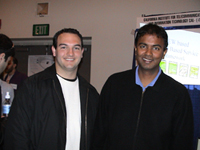 |
|
Nick Hill and Ganz Chockalingam, SD Wireless Traffic Report project
|
|
2.27.04 -- The UCSD Division of Calit² demonstrated seven projects at today's Jacobs School of Engineering annual Research Review. Ganz Chockalingam, a principal development engineer, demonstrated the San Diego Wireless Traffic Report, an advanced traveler information system that allows commuters to personalize their traffic reports and review them on demand through their cell phones. Commuters can find the quickest way to their destination based on the current traffic conditions.
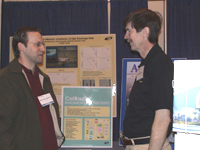 |
|
Doug Palmer (right), principal development engineer at Calit²
|
|
Doug Palmer, principal development engineer, presented CalRADIO I. This is a WiFi research and development device that consists of a TI high-performance 5410 DSP, a 16-bit stereo CODEC, external Flash and SRAM memories, and support of a RF LAN module. It provides a convenient platform for development of RF radios from the physical layer up to the application layer. The key benefit of the board is that all aspects of the MAC are coded in "C" on the DSP and, therefore, are altered easily for research in queuing, security, ad hoc networks, power management, and so forth.
Palmer also presented a demo related to the upcoming Autonomous Model Yacht Racing Competition. Calit² researchers are supporting the efforts of UCSD to be the first to achieve the remarkable goal of sailing a 10 Kg autonomous watercraft from San Diego to Tahiti! This race requires radical new engineering technology in power management, navigation, seamanship, artificial intelligence, hydrodynamics, and energy generation from sun, wind, and wave.
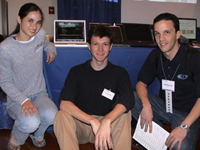 |
|
Serge Belongie (right), leader of the Smart Vivarium project, with students Kristin Branson, CSE, and Vincent Rabaud, CSE
|
|
Serge Belongie, assistant professor of CSE, and his graduate students demonstrated Calit²'s Smart Vivarium. UCSD's vivaria contain thousands of rodent cages, making close monitoring of individual animals impossible. Both animal care and experimental data collection would be improved by constant monitoring. The goal of this project is to automatically analyze the behavior of mice in a cage using video surveillance. The first step in automated behavior analysis of individual mice involves estimating the position of each mouse in each frame of video. Next, the mouse positions and domain-specific cues are used to label the instantaneous behaviors of each mouse. Finally, mouse behavior over time is catalogued and analyzed to determine the health of each mouse. This demonstration presented the approaches and preliminary results for each of these steps.
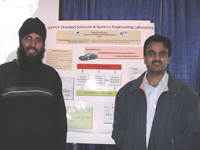 |
|
Ingolf Krueger's students, Jaswinder Ahluwalia and Diwaker Gupta
|
|
Assistant professor in-residence for CSE, Ingolf Krueger demonstrated Automotive Electronic Control Units. Software has become the enabling technology for most safety-critical and comfort functions in the automotive domain. Today's luxury cars contain up to 80 electronic control units and five different, inter-connected network platforms, over which some 700 software-enabled functions are distributed. Krueger presented a software and systems engineering approach for automotive software, encompassing the whole range of development tasks from model-based requirements capture to design, implementation, and validation of the resulting systems. This research is being conducted in collaboration with partners from the automotive industry, specifically with Ford Motor Company and the Toyota InfoTechnology Center, funded by the UC Discovery program.
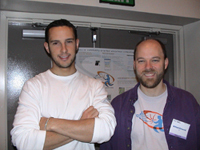 |
|
Bill Griswold (right), ISS layer leader of Calit², and Etienne Pelaprat, Communications Department
|
|
William Griswold, Interfaces and Software Systems layer leader of Calit² and professor of Computer Science and Engineering, presented UCSD ActiveCampus - A Mobile Wireless Living Laboratory for Ubiquitous Computing. Mobile wireless computing has the potential to strengthen campus community through processes of indirect mediation. UCSD ActiveCampus comprises an infrastructure for community-oriented ubiquitous computing and a social network of researchers, educators, administrators, and community participants. This demonstration introduced the ActiveClass and ActiveCampus Explorer suite of community-oriented services, and discussed early results in their use. ActiveClass is an in-class application for encouraging classroom participation, especially amongst shy students. ActiveCampus Explorer uses location awareness to help you stay in touch with colleagues, discover interesting activities in the immediate area, and support personal expression.
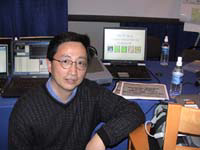 |
|
John Zhu, who's working on Calit² BREW applications
|
|
Professor Ramesh Rao, director of Calit²'s UCSD Division, Calit² principal development engineer Don Kimball, and graduate student Manishkumar Patel demonstrated Communication Protocols for Efficient Battery Utilization. This emerging area of research is extremely important to wireless device performance. The team has conducted several experiments to examine the advantage of constant pulse current discharge over continuous current discharge. They identified the phenomenon of charge recovery as a mechanism that can be exploited to enhance the capacity of a battery. The charge recovery phenomenon can be observed under bursty or pulsed current discharge: if a cell is allowed to relax long enough after delivering a pulse, charge recovery takes place at the electrode. The bursty nature of many data traffic sources suggests that data transmission/reception in wireless communication devices may provide natural opportunities for charge recovery.
Calit² partners Conexant, Hewlett Packard Company, QUALCOMM, SAIC, Sun Microsystems, and the UCSD Center for Networked Systems, among others, also participated with research exhibits at the review.
 |
|
Sun Microsystems' exhibit
|
|
|
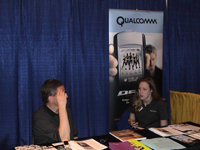 |
|
QUALCOMM's exhibit
|
|
| |
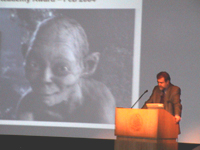 |
|
Frieder Seible, Dean of Jacobs School of Engineering, speaking of Henrik Wann Jensen's academy award received for technical achievement
|
|
|
 |
|
Andrew Chien, leader of the OptIPuter middleware team and director of UCSD’s Center for Networked Systems, with Matti Hiltunen of AT&T
|
|










